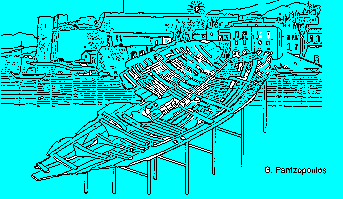

RECONSTRUCTION
The complex venture of restoring the ship, that required patience and scientific expertise, was made by professor J. Richard Steffy, a UNESCO specialist attached to the Antiquities Department. Mr Steffy studied the ship for years from its structural point of view and knew most of the details and peculiarities of its construction. This is how he explains his undertaking:"As nothing is known about the ancient shell first method of shipbuilding, we first had to construct a research model in order to find out the techniques of ancient shipmakers. It is 1l5 of normal size, with a pinewood frame, copper nails and pegs and oak wooden tenons that hold the beams together. It proved to be a useful model, as we learnt a lot about the craftsmanship of the ancient shipmaker. For example, he did not make any use of geometry in constructing a ship. We were also able to discover some faults in the stern, which we later corrected. Without this model it would have been impossible for us to restore the ship to its original shape. "
From the CyBC documentary "With the captain and three sailors - the ancient ship of Kyrenia".
Crew:
It is estimated that the ship's crew consisted of four
persons, as can be seen from the utensils they used for
eating, of which there were four sets:
4 small plates
4 water bowls or mud-barges
4 oil pots
remains of 4 wooden spoons.
Utensils
In addition to the above the following were found:
several small jugs
1 saucepan lid
1 clay and 1 copper cauldron
13 pots of the "sea-urchin" type with black varnish coating.
Other objects - finds
Lead net-weights were also found, allowing us to assume that the crew used to fish during the voyage, apparently to satisfy their daily needs in terms of food.
Among the various finds, there were also chunks of lead and iron which were used for repairs, as well as a wooden mallet with which they beat the metal before use.
Eight spearheads, some of which were bent by
thrusts upon the ancient ship, are among the most important finds. This allowed scientists to assume that the cause of the shipwreck was a piratical attack, a hypothesis which is reinforced by the fact that no valuables or sailors' personal effects, apart from only seven copper coins, were found.
Coins:
Though badly oxidized, two of the seven coins were of considerable help in determining the period when the ship sank.
On two coins the representations were recognized and the age they were minted, the Hellenistic age, was determined. One of them, which was issued during the reign of Antigonus the One-eyed (316 - 301 B.C) depicted a shield with a lion's head in the front and a Macedonian helmet at the back. The other copper coin, which was issued during the reign of Antigonus' son, Demetrius the Besieger (306 - 294 B.C), showed a helmeted head and a ship's stern.
Remnants of food, food, provisions:
Remains of foodstuffs found on the ship were:
a clove of garlic
18 olive stones
about 14,760 fig seeds
about 10,000 almonds with their shells.
Cargo - Merchandise:
A laboratory analysis showed that the almonds, which were certainly carried as cargo, had been picked around 288 B.C.
404 amphorae in all, most probably manufactured at the end of the 4th century B.C, were found. Different types of amphorae were recovered, which indicates that they were loaded at different ports with local goods, e.g wine from Rhodes and Samos, fruits - almonds possibly from Cyprus.
The basic types of amphorae were three: small and large amphorae from Rhodes and the ones from Samos. The most common type was the Rhodian one, which, according to specialist Virginia Grace, belonged to the end of the 4th century B.C. There were circular or rectangular seals in only 34 of them, with the initials
ARI that apparently belonged to the craftsman who made them. An O in a circle was printed on the handles of five of the amphorae from Samos.
29 large igneous stones of a dark hue and in different sizes with a total weight of 1,652 kg were also found, used in sets of two as millstones. The fact that there was an odd number of these stones and that only a few of them were "finished", i.e had the necessary holes for the wood which would serve as a handle for those who would turn the stones, led to the assumption that the millstones were not carried as cargo but were used as ballast. At any rate their igneous nature denotes their place of origin, which is the volcanic islands of the Aegean - Kos, Nisyros, etc.
Navigation:
The ship had a square a sail with estimated dimensions of 10.7 X 6 m. (or 64 sq. m.).
Reefing was carried out upwards with reefing-brails that went through 10 vertical rows of lead-rings sewn on the canvas. The crew could move the entire mast and the sail into different positions along the keel in order to balance the load and make adjustments according to wind and sea conditions.
On the left and right side of the bow there were two quarter-rudders or steering oars with two helms which could work together or rise from the water independently of each other.
Dimensions:
The ship was approximately 14.75 m. (47 ft.) long, 3.4m. (14.5 ft.) wide and had a draught of 1.4m. at the bow and stern.